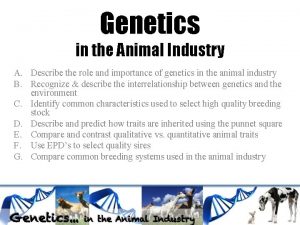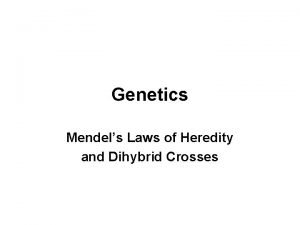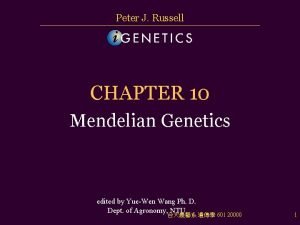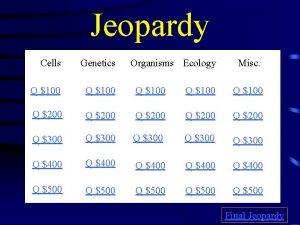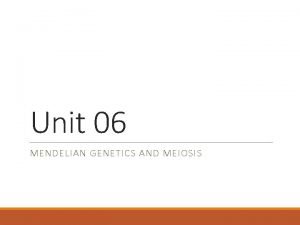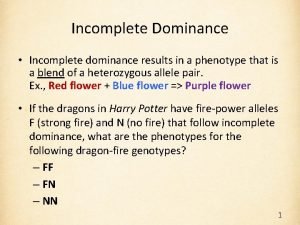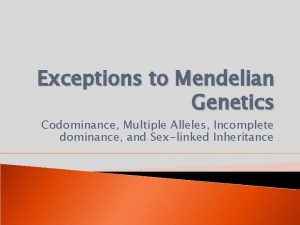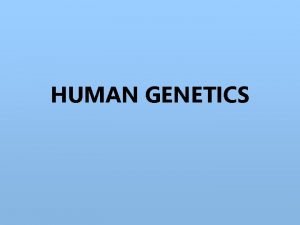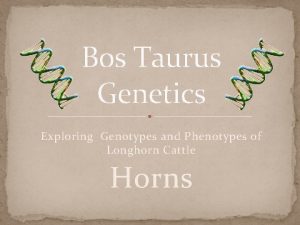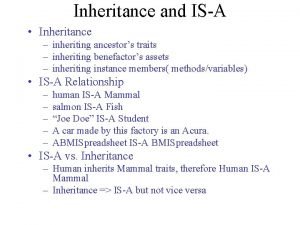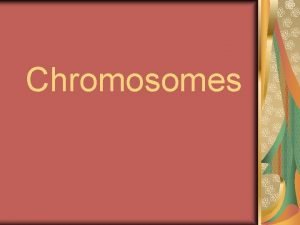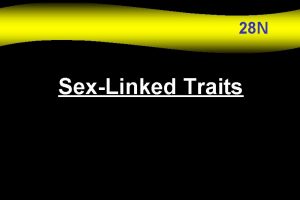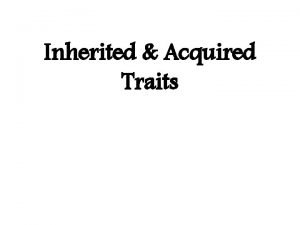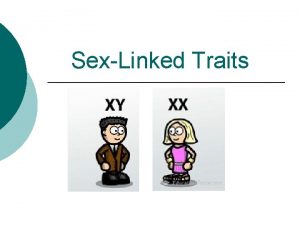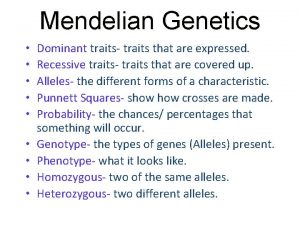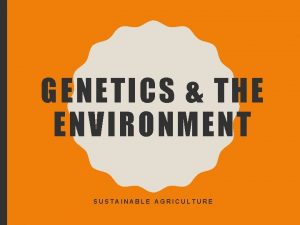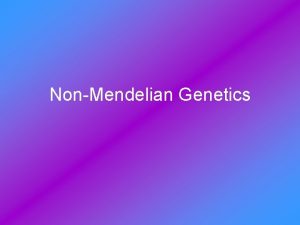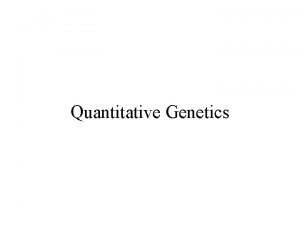Genetics Inheriting Traits I Inheriting Traits A An














- Slides: 14

Genetics: Inheriting Traits

I. Inheriting Traits • A. An organism’s characteristics is the collection of many traits inherited from its parent(s) • 1. Heredity- passing of traits to offspring • B. Traits are determined by genes on chromosomes – 1. Alleles are different forms of a trait

II. What is Genetics? • A. Genetics- the study of how traits are inherited through the interactions of alleles • B. Gregor Mendel “The Father of Genetics” 1 st to trace one trait through several generations. – 1. Mendel used pea plants and probability to explain the process

Mendel “The Father of Genetics” ▣ Mendel was a monk ▣ When he was a young child he loved plants ▣ Work with thousands and thousands of plants during his lifetime

III. Mendel’s Garden • A. Mendel knew that parts of a plant produced pollen the male sperm and other parts female similarly produced eggs cells. When these 2 cells came together it was called fertilization and developed into an embryo. – 1. Most of his plants would self pollinate themselves creating children that had identical physical characteristics from their single parent this is known as true-breeding. • Mendel was curious to produce seeds from 2 different plants or cross-breeding

III. Mendel’s Garden ▣ B. Mendel crossed two plants with different expressions of a trait (a specific characteristic). � 1. New plants from the crosses looked like one of the two parents he called hybrids Ex. Tall Pea plant mate with a Short pea plant = Tall pea plant offspring **Note: Why are all the offspring Tall and not Short?

III. Mendel’s Garden cont. • C. Mendel noticed when cross-breeding plants some traits seemed to disappear while others were always present – 1. Traits (alleles) that are always present and seem to cover up the other trait are dominant – 2. Traits (alleles) that seem to disappear or are “covered up” are recessive

IV. Segregation • A. Mendel wanted to answer his own questions did all the recessive traits disappear – 1. He took the offspring from the 1 st cross and crossed them with one another – 2. The result…the recessive traits reappeared In conclusion • B. When gametes are produced the 2 alleles segregate from each other so that each gamete (sperm/egg) carries a single copy of each gene.

V. Using Probability • A. Using probability helps you determine or predict what a cross’ offspring will look like. In other words which gametes will come together • B. Punnett squares- a tool to help predict and compared genetic variations that will result from a cross Parent 1 X Parent 2 Allele 1 Allele 2

V. Using Probability cont. • C. The Alleles are represented by Upper and Lowercase letters – 1. Uppercase letters =dominant traits – 2. Lowercase letters =recessive traits

VI. Alleles Determine Traits ▣ A. Every cell in your body has at least two alleles for every trait located on chromosomes. � 1. If an organism has two of the same alleles the trait is known as homozygous �A. Ex. TT or tt � 2. If an organism has two alleles that are different it is known as heterozygous �A. Ex. Tt ▣ B. The two letters for each trait (genetic make up) is called the genotype. ▣ C. The way an organisms looks is known as the phenotype.

VII. Punnett Squares • A. Place two alleles for one parent on the top and the two alleles for the second parent along the side • B. The square is then filled in with one allele donated by each parent Parent 1 X Allele 1 Parent 2 Allele 1 Allele 2

VII. Punnett Square cont. �C. Cross a Tall plant homozygous dominant with a Short homozygous recessive plant Tall Plant Short Plant X T T t Tt Tt �What is the probability the plants will be Tall? Short?

Lets Practice • Heterozygous Tall pea plant with Heterozygous Tall pea plant • Heterozygous Tall pea plant with a homozygous recessive short pea plant • Homozygous Tall pea plant with a heterozygous Tall pea plant
 Inheritance of quantitative traits
Inheritance of quantitative traits Qualitative traits vs quantitative traits
Qualitative traits vs quantitative traits Qualitative traits vs quantitative traits
Qualitative traits vs quantitative traits Nature genetics
Nature genetics Rednwings
Rednwings Blood type mendel square
Blood type mendel square Branch diagrams genetics
Branch diagrams genetics Ecology jeopardy
Ecology jeopardy Genetics
Genetics Sexual reproduction and genetics section 1 meiosis
Sexual reproduction and genetics section 1 meiosis Harry potter genetics incomplete dominance answer key
Harry potter genetics incomplete dominance answer key Multiple alleles
Multiple alleles Gregor mendel
Gregor mendel Who is the father of genetics?
Who is the father of genetics? Taurus genetics
Taurus genetics


